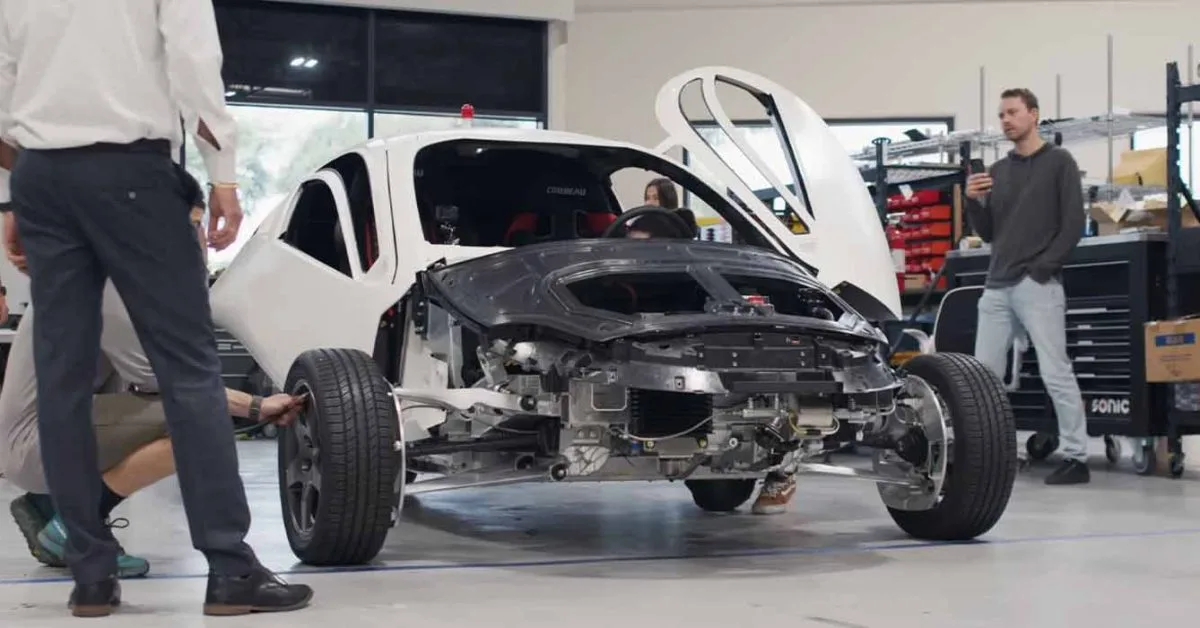Something I find incredibly weird about US company culture is how they talk about overtime like it’s a good thing.
“Our employees worked weekends, days and nights to make this happen! We wouldn’t have succeeded without people who are willing to give up their personal lives!”
I hope they not only succeed but get shares. Doing weekends or nights for a company you don’t (partially) own feels like a con.
Find people who care about what they’re working on and they’ll go well beyond the extra mile. As an extra motivator, make it clear the company won’t be around if they don’t succeed. I’m sure these employees have shares, but tha only really matters if the company succeeds (extra motivation!). Unfortunately, there have been a ton of green/green-adjacent automotive “startups” that have struggled to gain a foothold. See also:
(I’m sure many others)
Here are a few other interesting green automotive startups that didn’t make it:
- Sono Motors’ Sion: Compact EV with solar panels, power sharing, intended to be easily repairable and included a detail manual. They had prototypes but never went to production. Now the company does niche solar applications.
- Workhorse: Series Hybrid (think Chevy Volt) Pickup truck with onboard power for tools etc (was announced around or even before Rivian). Was a very pragmatic idea IMO. Later sort-of resold to Lordstown. Now company does some other things, like drones.
- Lordstown Motors’ Endurance: EV Pickup Truck with hub motors. Made a few hundred, but they have been dragging it out long enough for Ford to make electric pickups. And the idea wasn’t too original even when it was announced.
Fisker is nothing but a conman, always has been. His MO is literally to start a company, secure funding, make a personal fortune and then abandon the bankrupt shell and leave customers hanging.
I was thinking about the US lately. Can’t remember why exactly maybe some friends popped up on my Facebook.
But I decided it actually wouldn’t be that bad of a place to live. If it wasn’t for the toxic work culture.
If they worked normal hours and had 20+ holidays it would be alright. Other shit annoy me and you would have to make sure you live in the nice areas but I could live there and enjoy it. But the work culture is an absolute no go. Wish they were like the Aussie. Show up do hard day of work fuck off for some beers. If the surfs good call in sick and end up seeing your boss in the line up. Work hard for a few months then decide fuck it and go to Bali for a weekend accidentally stay there for two months then decide you need to go back to work because travelling is too much effort walk into a job 1 week after landing home.
it is a con
Nothing says product quality like overworked employees
There’s something that people really fail to grasp with solar, and that’s the fact there is bugger all energy in the sun, and you need a huge surface area to get any meaningful energy.
A home solar array often takes up a significant chunk of the roof area, and the amount of surface area a car typically has means that even perfectly efficient solar panels wouldn’t collect enough energy to significantly contribute to the vehicle’s range.
There’s a good reason why vehicle manufacturers don’t bother adding them.
Yes, but with a light and efficient vehicle, along with enough area covered in solar, it should be able to get you about 15 miles of free travel when left out on a sunny day. It has a battery. It isn’t just running on sunshine and lollipops.
Or 43 miles in Aptera’s case
I’ll believe that when I see it.
I’m not believing they’ll get even close to that in a production vehicle that’s US street legal.
The body weighs around 360kg, with a 60kwh battery it supposedly weighs around 800kg (the smallest and lightest option is 25kwh), with a drag coefficient of 0.13.
In comparison to some of the most efficient cars - the Hyundai Ioniq 6 is around 1,860kg with a drag coefficient of 0.21. Tesla Model 3 is around 1760kg with a drag coefficient of 0.219.It’s going to be a whole lot more efficient than the average car just based on these numbers.
Now it depends on how much of the car’s surface will be covered by the solar panel and what’s the panel’s efficiency.
The Honda civics in the 1980’s weighed around 800 or so kg as well. You know one of the reasons they got heavier? Crash ratings and safety features.
So once again I’m calling bs that they will get 45 miles out of this. Even if they got it classified as a motorcycle and scape around the car safety requirements, it still won’t get a real world 45 miles a day from solar charging. Your math will never add up to that.
The Honda Civics of the 1980s did not have a drag coefficient below 0.2
Come back in a year or so and we’ll see who has to eat their words.
That’s a weird comparison to make. The Aptera is smaller and uses different materials.
Afaik it’s going to be classified as a motorcycle in many states in the USA, but they’re still aiming for a high rating. I know they have crumple zones and a safety cell made from composites akin to F1 cars.
Whether what they’re planning will be enough, we’ll only know for sure once they test it.The math works quite well as long as the information is accurate.
Of course things can always turn up to be different in the end product.
But from the information we have now, ~4 hours of good sunlight conditions will be enough for 43 miles.
They are skirting the “street legal” and safety stuff by making an electric motorcycle instead of a car. Months (years?) ago I read something about how they are planning to tackle helmet laws in court because of this. Accident safety features are heavy, this thing is going to be a death trap on US roads in order to be as light as possible.
Overall I think that’s the right move, but I wouldn’t get in rush hour traffic in this thing.
That’ll help keep it as light as they’re planning. They still won’t get 45 miles a day on solar unless they’re doing 15mph on a flat road in Nevada during the summer. No way would it be an expected rating.
You should actually watch their videos and do some research before spewing your speculations. Seems like it’s going to be pretty safe to me.
I’ve watched plenty of their videos. Despite how you took my message, I’m actually very excited and hope they make it to full production. But if you think that thing is going to be safe enough when some a-hole in a Tahoe t-bones you, you’re going to be very disappointed. The problem isn’t the Aptera, it’s the ridiculous sized SUVs already on the road.
Yeah, this is why it’s dumb. When is a parked car parked ideally to capture sunlight? Just put the money into solar panels on a building or in a field, charge your car when parked, and you have a much better and cheaper product. The solar panels on the building can also be used to power other things, unlike the car. It’s such a stupid idea and will be very expensive to get custom panels for the car that aren’t super fragile and also efficient. Just spend that money and larger cheap panels. This is purely to get VC funding and nothing more. It’s a waste of time and energy.
In america? Litterally everywhere. Even driving down the highway would get trickle charging.
If your expecting to fully charge from the panels, youre gonna have a bad day. But every extra mile would overcome the cost over its lifetime.
Again, I said ideally. When will it ever outperform solar on a rooftop of the same size? How much more size could you get for the price?
It would never overcome its opportunity cost, even if it recovers it’s cost (which you’re speculating on and have no idea of the cost). You could spend the extra money for a solar car, or spend the money for rooftop solar. Rooftop solar will always outperform it for the price, so you have a negative opportunity cost.
Look at you owning a rooftop to put solar on.
A lot of americans are renters and that number is unfortunately growing.
The apartment I was last in was several stories tall and, as such, the parking lot was shaded most of the day. Most of the parking spaces were even in a parking garage, so they get no sunlight. If you’re in an apartment, odds are this won’t work for you either.
There are companies working on non-permanent balcony solar though, which isn’t as good as rooftop but still something. That’ll still only work for probably about half of apartments (facing east or west), but it’s inexpensive.
We do need solutions for apartment dwellers, but a solar car probably isn’t it. We need to require a certain amount of availability of electric charging at apartments, and we also need better public transportation options and bike Infrastructure. This is a gimmick solution, not a real solution.
I mean, it’d be cool to get a couple miles of range here and there without having to plug in. Could make for a nice little errand vehicle in a smaller city where there aren’t trees or tall buildings to block light and you just park in a driveway or apartment parking lot. If say the battery itself would be big enough for an 80 mile range, I could see some people never having to plug this car in.
It’ll come down to price, of course. If it’s cheap, it could be cool and useful. If it’s expensive, it’s a novelty and would have no practical reasoning to be purchased.
The base model has a 250mi range, and the biggest boi battery is estimated to get close to an 800mi range. The batteries are almost half the size of other EV batteries because of how efficient this vehicle is.
That’ll be super interesting if it ends up staying that way.
It will not be cheap. It’s going to be the price of an EV + the price of custom shaped solar + the price of R&D + the price of being a niche product and not having the efficiency of scale. It’ll be a novelty without any doubt.
Everything takes r and d. Also, it’s not “custom solar panels” anymore if you’re ordering 10,000 of them. The article stated that supposedly they have a ton of pre orders of sorts. Custom means a one off, or even a few dozen of something. Not thousands.
Everything requires R&D, but doing more things requires more R&D. It’s not just an EV, which requires it’s own R&D.
Custom means it has one purpose, not that it’s a one-off. No one else will be using the same panels they will be, so they don’t benefit from the scale of mass-produced panels (and 10,000 is not a large number even if that’s the number they have pre-ordered).
15 miles a day under ideal conditions isn’t really a significant amount, most EVs could run for multiple weeks without being charged under those conditions.
I currently have an ICE car, and with how much I use it, 15 miles a day getting added to the battery on average would probably cover most of my usage. And you can still plug it in for longer trips. You’re not forced to rely on solar alone.
That’s 100 free miles a week. Sure, most people will need to charge it anyway, but that’s still 100 free miles a week.
But I don’t think it’s a good idea. It would be more efficient to just put the same solar panels in your roof, where they don’t contribute to the car’s weight, don’t force your to park in sunlight instead of indoor parking or garage, and whose output can be used for charging the car OR for anything else as needed.
That’s ideal conditions, so very few people would actually see that. If you don’t have somewhere to charge, you can typically charge up at somewhere like a supermarket.
It’s not any more free than any other EV. it still uses energy. That energy can only be used for the car though. Put some solar on your house and it can charge your car (not free, the price of the panels same as the car). It will also be more efficient because it can be placed ideally, unlike the car. It’ll also be cheaper for a larger area because it can take advantage of cheap standard panels instead of expensive custom ones.
Yeah, that’s what I said.
Their tech isn’t just the solar, they’ve optimized the car solely for efficiency. They claim their car can get 10 mi/kwh, so with 700W of solar panels they can get up to 40 miles of charge per day with just the solar. By contrast, the solar panels that are available on the new Prius get 4 miles of charge per day.
Now that their production-intent vehicles are just starting to be built up, I’m eagerly awaiting their actual test data that hopefully verifies their claims on efficiency, range, crash safety, etc. but we’ll see 🤞 I really hope they succeed.
Yes, the aerodynamics + solar panels is what makes this vehicle enticing, not just the solar panels alone.
There is good amount of energy in the sunshine. The output of solar arrays struggle to make big power out of small surface areas because we haven’t figured out how to get more than 20% of the power that hits the panel. If they do get 20% or more, it’s been with very expensive and fragile panels.
Solar panels are also added weight, which reduces range. Any way you look at it, it makes more sense to have the solar panels at a base location you go back to.
I guess an RV, or a camp trailer, makes sense to have panels on it, but that’s about it
There’s also things like Sentinel mode on Teslas that use power.
My main gripe is people think a solar car will never need to be charged, or only on trips, and that’s just not the case.
Aptera claims to be able to get 40 miles a day via solar. Most people drive less than that per day.
Solar panels are incredibly thin and light. There is no reason not to include them.
Price. Large standardized panels are cheaper. Until you cover static otherwise unused space with solar, there’s no way this car is a better use of money.
Been following this company’s development for over a decade now. I really want them to succeed but I have major doubts.
I want them to succeed. I really hope they do.
It’s good to see that Aptera is still a possibility!
For real. I was so hopeful for the Type-1 and would’ve reserved one if I had the money.
It’s also a bit strange to see a production-intent build of a solar electric vehicle without any solar panels. Still, Aptera shared that technology will be implemented next alongside the SEV’s production-intent thermal management system and exterior surfaces.
This thing is pure vaporware. My new Leaf isn’t.
Im not saying it isn’t, but fitting custom curved prob special solar panels on a test vehicle does not sound cost efficient, especially when you can test the solar panels separately perfectly fine.
Cars are complex to construct properly even without drivetrains, plenty to test there.
True, but my understanding is the amount of solar energy that hits an area the size of a car multiplies by the max possible solar energy conversion is still far below what’s needed to power a car. Sure, you can continue to charge it while parked, which is cool. However, you could also put cheaper non-custom panels on a building and then plug your non-solar electric car into it to charge while parked, and the building panels will have significantly better solar exposure and be cheaper per panel.
If your goal is making something effective that reduces carbon output, an EV and solar on a building is much better. If you’re creating junk to get VC funding, this is what it looks like. If this comes to market at all, it’s not going to make any waves, except maybe for how impractical it is.
I could see a market for a small electric camper van (Like actual small van sized like the old VW vans) with a solar roof. For regular camping you would always have electric to charge your phone and if you wanted to tour around a bit you could probably stay at each location for 2/3 days and gain enough charge to make it to the next one (at least in summer)
You can get teardrops with solar panels, but I haven’t looked into electric RVs.
For sure. I’ve always lived an idea like that. You can buy portable solar panels you can throw up on your roof when parked though, or place them elsewhere, so I don’t know if it’s required. It’s a concept I could see actually working though. Not this.
You’re taking for granted the fact that many people don’t have the luxury of modifying their house/condo/apartment to install and maintain solar panels. Nor is it guaranteed that they have a garage/driveway to charge their car. With the Aptera, you wouldn’t have to deal with the hassle or inability to install solar panels because you would be able to passively charge it anywhere it’s sunny (i.e. while driving as well). So I disagree that this is just an objectively worse option than charging with rooftop solar, especially because of how competitively priced the Aptera will be compared to standard EVs.
Youd probably have a better time designing a popup thing for the top of a car that has solar panels. Then you dont need to deal wigh the body shape of the car while still being able to maximize the output to a decent degree depending on how complex you want to make it.
Solar panels aren’t worth it for a normal EV, but supposedly the Aptera is so small, lightweight, and aerodynamic (with that teardrop shape) that they actually add a significant amount of range.
Oh, I agree with you there (well, not in the tech itself, why not both, have panels on buildings and on some cars – plenty of people drive only a few thousands of kilometres/miles per year & still need a car).
I’m just saying that as engineer I would start testing them separately, in lab conditions first to get the basics & correct obvious initial faults, then separately outside.
As management I however would insist that engineer has to find a way to glue whatever solar panels they can find to the prototype if there is gonna be a press release.I didn’t read much what they are doing/going for tho, so can’t say much about that.
Why not both is because most people don’t have unlimited money. It’s about opportunity cost. It’d be better to buy a cheaper EV and better rooftop solar than and expensive EV that has mediocre solar charging.
For sure they should test them separately if they’re doing this though, or at least not use custom ones for the prototype. You can buy small panels for a reasonably good price, and they could just stick those on the car for a proof of concept. The problem with this is it’d prove that the amount of power required is way more than is going to be generated. If they can talk about concepts then then people can still wonder “what if…” If they actually implement it then it makes it obvious there’s no reasonable path to a good market and they lose FC funding.
In a free market and under current western capitalism the final consumer price (or entire consumer market supply for that matter) isn’t directly linked to features.
Ie they will sell you at max price as little as they can, not at a cost based price.
(Anyway, a cars worth of solar panels is such a negligible cost in relation to cars base price or options lists that it doesn’t matter that much)And I don’t ever think you need any kind of prototype or testing to show how much solar energy can a surface of a car produce and how much travel distance does that represent - to ballpark it that is just a simple online search (you have enormous quantity of solar panel efficiency data, per latitude, as well as actual electric car consumption rates).
Bcs of that obvious common sense & various types of other solar cars out there I really doubt anyone is getting deceived here on solar mileage. The company does not claim they invented any revolutionary new solar panels (I doubt they hide the wattage spec they intend to install), nor hide the car (it’s a design 10+ years old, the point of which is that it has about a 0.1 drag coefficient, so about half of that of the sleekest other cars today). Their goal here is to put the existing design into production, so more of a logistical challenge - their prototypes need to prove they can build cars (to establish a production line), not to prove any overall concept of a solar car itself.
Additionally you can already get Hyundai Iconiq 5 with a solar panel sunroof for years now, it ads a mile/kilometer per day in real life (for people with a couple of miles/kilometre commutes that’s actually noticeable). But for decades you could get some car models (Toyota & Audi at least) with a solar panel sunroof, mostly they just powered the 12V battery with it to run auxiliary systems (like ventilation, AC).I think you might have jumped to the conclusion this company is trying to sell solar cars with unlimited (outside?) range.
I think you might have jumped to the conclusion this company is trying to sell solar cars with unlimited (outside?) range.
No, I jumped to the conclusion that it must be less effective than the alternative of rooftop solar + conventional EV. There is no world in which this is better. Rooftop solar will always have better solar access, and conventional EV will be cheaper because of effeciency of scale. This design is limited to powering the car only, and will never be as ideally situated as rooftop solar. The opportunity cost of this car will be worse than rooftop solar + EV. Sure, for people with unlimited money it might sell, but most of us don’t have that and have to compare cost to value and choose the best option for that.
I have rooftop solar, but only for the house because I can’t reach my car to charge it in the street.
The car sits outside for days (I work from home), so in my case this would be great.
This is the 1st I’ve seen of this car, so haven’t read any other details, but I’d be surprised if external charging wasn’t possible.
Sorry, but what sort of conclusion is that? I don’t understand, it’s divergent things.
Lots of tech that cars offer I can also have at my house, like a sound system or massage chair.
Car prices don’t reflect constriction costs.
Cars won’t be more or less expensive bcs of 200$ of solar panels.Also people with budgets constraints dont buy new cars, why would they?
The car is efficient enough for it to do something (20-30 miles a day in summer if I remember), but yes it’s mostly marketing and they say as much. “Solar electric car” sounds a lot better than “this car is pretty normal but it’s super efficient”
No one is trying to take away your Leaf, though.
Let them push the envelope. Failing is a required pavestone on the road to almost every success story.
I suppose that the solar panels are in a field somewhere. It’s much more efficient.
I’m excited to see them succeed. I love it when stuff is designed with function over form, and made practically. I’m a tall person, this is the only small electric vehicle I feel I could actually fit in
A few things the cynics are missing.
- The engineers who are designing this car don’t have the political power to push for better mass transit.
- Even in ideal circumstances, there will still be a need for personal transport vehicles and infrastructure. Small cars will still be needed.
- Aptera has 31 employees as of 2023. If they’re working overtime, it’s because they’re letting the company do it. Maintaining good moral is way more important in small companies.
Please just do trains. They can even be solar powered - a lot easier than this.
Trains are easy and they’re easily electrified already. So putting solar on the trains won’t have any advantage.
Rails are the difficult part of railways. They never seem to put them between my house and my work. They’ve put something called a road in between instead.
I presume they meant to put in railway infrastructure.
Railways cost so much less than one highway, we could have a system basically from home to work.
(eg smol trams to a midway se station to high-speed trains)Is that true in California? Caltrain is costing $5.15 billion per mile.
I note with interest that you are repeatedly posting the same cherry-picked factoid.
Average cost per mile for new track in the USA can be anywhere from $100mil/mile to over $1billion/mile for complicated projects like tunneling. This is roughly 50% higher than Europe - most likely for the simple fact that they have a larger industry for it. These are both quite high on an international scale- China builds new track for 24-48mil USD per mile.
Caltrian is not California High Speed Rail
Ok? The point is that rail development is expensive and like an order of magnitude the cost of Aptera. Ideally we could do both but they shouldn’t be put into the same bucket.
No it’s not, railway infrastructure comes at a fraction of a cost of highways, the maintenance alone, all the tires, fuel, insurance, etc of cars, even the environment impact (in like the area they cover/destroy) is minute.
All that costs, somebody has to pay.
Really? So we can install thousands of miles of rail for under a billion dollars? Let’s do it!
You mean the huge underground train station & several miles of tunnels around if, with all the work preformed underneath an undisturbed city?
Yes, that is still waaay cheaper than constructing an underground highway of that magnitude/that area (+ an underground station you conveniently included in the estimate) .
Or did you have something else in mind?
Why would you build the highway underground?
Same reasons as railway I suppose - its expensive to destroy a city centre to get the land needed for it.
But you started the comparison with the underground thing.
But the city already has highways. If we started fresh sure let’s do more rail.
My point is just, what infrastructure can you do with say <$1b? It’s a lot of money but not building a whole new railroad kind of money. You can get a few station upgrade projects, a couple of electric trains, etc.
There’s room for private funding of a new electric car company. Save the tax dollars for big infrastructure projects.
Kind of a different scale. $5.15 billion per mile of track for Caltrain. Aptera hasn’t even broken a billion in funding.
I note with interest that you are repeatedly posting the same cherry-picked factoid.
Average cost per mile for new track in the USA can be anywhere from $100mil/mile to over $1billion/mile for complicated projects like tunneling. This is roughly 50% higher than Europe - most likely for the simple fact that they have a larger industry for it. These are both quite high on an international scale- China builds new track for 24-48mil USD per mile.
$24-48m per mile is still quite a lot. It’s just not the same scale in expense.
Trains are already electrified.
Yes. That is the point.
As much as people on Lemmy love trains, they’re not replacing cars no matter how good the infrastructure is.
I think the goal is they can replace cars a ton of the time for a ton of people. Take the train to work and then rent a car for the occasional road trip.
It’s a noble goal don’t get me wrong, but cars are just way too convenient to get rid of for most that don’t live in the central zones of cities. Just things like taking your kid to their swimming lessons, evening activities, going to the tip and garden centre and dropping off at your parents en route, visiting friends that are several villages away, kids birthday party and then going to the supermarket after to pick up some food etc.
Something I’ve noticed is that people on Lemmy never seem to advocate for busses, it’s always trains.
Bummer. I want to give them my money, but they’re not accepting new investments right now.
Lots of people here criticizing Aptera who clearly haven’t researched the company or the tech.
A solar powered car that topped at 70mph would be ideal,
But goddamn, could you imagine just having one that topped at 30 MPh in a city? Infinite travel!
If you can park on top of a parking garage, or in a spot on ground level where sunshine is not too much blocked by the surrounding buildings, you could surely commute on sunshine. Home parking barely matters for day shift workers in this scenario.
Oh. That absolutely won’t happen. You’ll be losing battery power while you’re driving around.
They can make all solar vehicles that will go and keep going as long as there’s sunshine, but they aren’t anything a regular person could use.
Yep. Iirc apterra does 100wh/mi and is covered with less than 1000w of solar, so you only make at most 10 miles of range per hour in perfect solar conditions.
We have that already; it’s called a bicycle.
The future of transportation everybody: a car.
that is not a car. It is a Reliant Robin meets the BORG

deleted by creator
Good, now keep the momentum up, Aptera. You’re so close to the reality.
The Aptera has been promised for over a decade now. I’m somehow amazed they are still trying.










